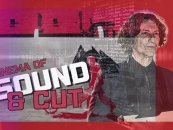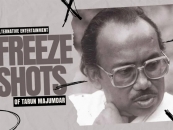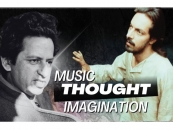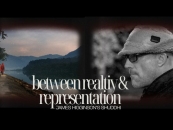-853X543.jpg)
When Atul Met the Movies
by Khalid Mohamed January 14 2022, 12:00 am Estimated Reading Time: 11 mins, 26 secsKhalid Mohamed in conversation with India’s prime, contemporary artist, Atul Dodiya, on his unbreakable bond with art and cinema.
Quite symbiotically, the film image ever since its inception has attracted accomplished artists, even superstars of the Indian art firmament.
Besides, of course the prominent example of the cinema hoarding painter turned pre-eminent artist turned filmmaker M. F Husain, one of the earliest Indian filmmakers Baburao Painter had excelled in oil painting, wood carvings, sculpture and set design, lending his birthplace Kolhapur the nickname of Kalapur. He went on to direct as many as 30 films starting with Surekha Haran (1921) – marking the acting debut of V. Shantaram to Bhakta Prahlad (1926), ending with Mahakali (1953).
Another significant instance, which could be cited in this context is the short film by the supreme master artist Tyeb Mehta who made Koodal, a Tamil word, which means a meeting point, an assembly of images. Here the camera enters an abattoir, emblematic of the violence of an angry mob transformed into the sanctioned violence of the butcher. The rarely-viewed documentary was a recall by Mehta of the horror he had witnessed during the subcontinent’s partition.
More recently, two Baroda artists Hemali Vedalia of Bombay and Suchi Vellai of Baroda were among the 115 international artists who contributed to the first hand-painted animation feature, Loving Vincent, produced by an U.K.-Polish collaboration.
Scores or our artists, including Chintan Upadhyay, have created film videos too as art installations or uploaded them on social media, to assert the corelation between art and cinema.
My focus today is on the nation’s A-lister Atul Dodiya, whose art has majorly brimmed with popular cinematic imagery. “So, when are you making a film?”, I’d asked him last year, to which he had shyly responded, “I do want to and will.”
Perhaps the pandemic has delayed his debut. Till he goes behind the camera, though his canvases and installations narrate stories, which strike you as vignettes of his abiding influences – from Satyajit Ray, Guru Dutt and Alfred Hitchcock to the Gabbar Singh of Sholay, Mohammed Rafi and Sridevi.
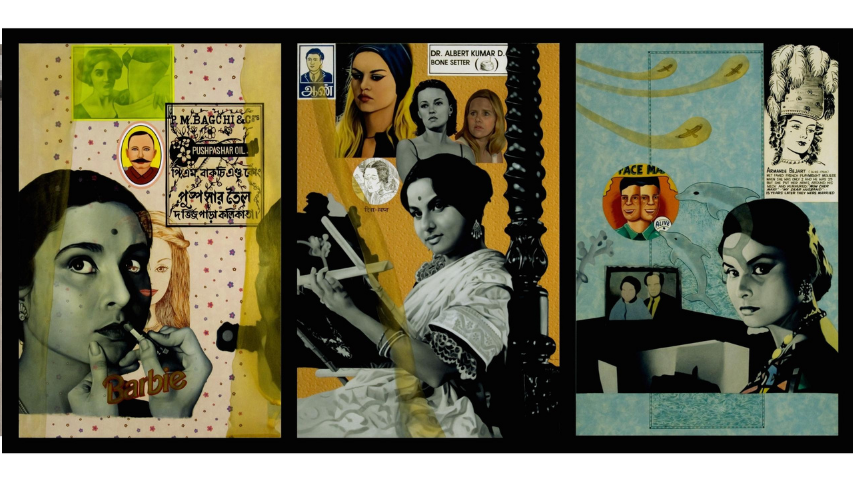
On a ‘phone conversation this week with Atul Doiya, I repeated the question:
Why haven’t you made a film yet?
Because I’m not equipped yet. Various technical aspects of making a film - be it scriptwriting, camera function, location selection, casting of actors, the shooting process, editing, sound mixing and interacting with the production manager - are beyond my expertise currently. If I have uploaded small videos on Instagram, that’s because they seemed beautiful to me and that’s it, just play. Jaise ki jhadoo maarna hota hai, just cleaning the base. If I do make a film, it will be obviously after assisting a practiced filmmaker.
The first film shoot I ever saw was of Seeta aur Geeta, a song picturised on Hema Malini and Sanjeev Kumar. Perhaps it was a stanza of their famous roller-skating song (O Saathi Re). It was quite exciting to see the paraphernalia, the huge mechanism involving klieg lights, reflectors covered in silver paper in broad daylight for take after retake.
And then in the Films Division documentary on Satyajit Ray, I remember the shots of Shyam Benegal filming Ray in action while directing Jennifer Kendal for a scene behind the piano for Ghare Baire.
Are there any filmmakers you’d like to assist?
There has been a mutual admiration with two young filmmaker friends: Chaitanya Tamhane who made The Court and The Disciple, and Gurvinder Singh, a Punjabi filmmaker who made the marvelous film Chauthi Koot (The Fourth Direction).
What kind of cinema do you relate to most?
I haven’t been watching too many Hindi films of late. I did like an Anurag Kashyap film.. no,no not Gangs of Wasseypur but The Girl in Yellow Boots, which had an unusual subject and visual style. And I make it a point to watch the work of Aamir Khan whom I like as an actor.
And which genre of a film would you go for?
It wouldn’t be abstract. It would probably be about people, their relationships while living in a city.
1.jpg)
That sounds close to the artworks of Sudhir Patwardhan.
Not necessarily,the entire film could be located in interior settings.
See, during the 1970s and ‘80s, I was exposed to cinema mostly at home, on television or video cassettes, whether it was a film by Guru Dutt, Vijay Anand or Hrishikesh Mukherjee. Every member of the family would have an opinion, whether they enjoyed or hated the story, the music, the performances, the ending. Their responses would reveal something about their own personalities. It was somewhat like the ‘Memory Game’ played in Ray’s Aranyer Din Rhatri. Perhaps my film would be somewhere close to that line.
Or it could even be something personal. Once at a party (filmmaker-photographer-writer) Sooni Taraporevala and I got talking, I told her I had studied at the J.J.School of Arts and graduated as a gold medallist. I began teaching at the school where Anju (Dodiya) had been in a junior class. We had started seeing each other, we lived at far ends of the city, she in Malabar Hill and I in Ghatkopar. We’d travel by bus route No. 137 from Crawford Market to Hanging Gardens, sitting next to each other but in silence since we didn’t want to become fuel for gossip.
We’d take off at times to screenings at the Alliance Francaise or to the galleries for an exhibition. The funny part was that we’d catch the bus back at 4 p.m., she would alight at a stop before Hanging Gardens and I’d catch the same bus back to travel in packed local trains to Ghatkopar. It was a strange boy-meet-girl story, a love story.
Sooni suggested that I should make a film on this, and I’ve often thought about that. It wouldn’t be a comedy per se but I would surely include some popular elements in the script. I’ve watched all sorts of films, after all.
Which filmmakers have been your major influences?
All the Satyajit Ray films. His visual sense, characterisations, his narratives, which have a profound impact. Of the international directors, my influences, if you want to call it that, would be Federico Fellini’s La Strada, Akira Kurosawa’s Rashomon, Ingmar Bergman’s The Silence and Francois Truffaut’s 400 Blows.
2.jpg)
In some of your artworks, there has been a deep fascination for the Bollywood villains.
Oh yes, Pran, Rehman, Ajit, Jeevan, Amrish Puri and more - they played such fascinating characters. They were the entertainers, I could connect with them far more than with the sweet heroes and heroines going through the rich-poor divide. When the villain entered, he disturbed everyone – the characters as well as the spectators. They were colorful, talked and dressed flamboyantly like Shatrughan Sinha did in his early roles.
That’s why I did an exhibition dedicating signboards of the 13 railway stations from Ghatkopar to V.T. to them. The last station, the 14th one which doesn’t exist, was for Bindu… the Shabbo of Kati Patang and the Mona Darling of Zanjeer. I named that station after me. Guess I was a crazy fan of the bad guys and the vamps who always had an edge over the goody--goodies.
How come you created a solo painting on Gabbar Singh?
That was for a commemorative event for Sholay. Ramesh Sippy’s daughter, photographer Sheena, had approached various artists for the event. That meant a lot to me since I’d seen Sholay at the first-day-first show at Basant Cinema in Chembur. During the interval, when my cousin Mayank and I were having tea, the audience was praising the film to the high heavens.
But some spectators, including Mayank, were grousing who’s this newcomer Amjad Khan. Why is he delivering his dialogue so oddly? Why couldn’t they have cast a more well-known villain? At that very moment, I’d told Mayank, this guy is bound for greatness, he will be one of the major assets of Sholay. The painting, I guess, germinated from that memory. This work eventually found space at the Fukuoka Asian Art Museum, Japan.
You’ve also done a rather tongue-in-cheek artwork of Sridevi.
I was in Kolkata, on the way to Shantiniketan, and happened to see a photograph from Roop ki Rani Choron ka Raja in the daily newspaper there. That led to the painting of Anil Kapoor pinching Sridevi’s cheek.
Frequently, I have taken images from the newspapers, as of dignitaries visiting the Taj Mahal - of Princess Diana, Clinton and his daughter Chelsea, Putin and his wife, and also of magician P.C Sorcar who had said he would make the Taj Mahal vanish. And I used playing cards in the background. This culminated in a triptych of sorts, which was quite a hit if I may say so. It was exhibited at the Kitsch Kitsch Hota Hai show in Delhi, curated by the India Today art critic Madhu Jain, and is in the collection of the National Gallery of Art in New Delhi.
2.jpg)
You’ve also created seminal artworks on the cinema of Satyajit Ray and Guru Dutt.
Essentially, the Ray oeuvre compelled me to create three portraits of Madhabi Mukherjee in Mahanagar, Charulata and Kapurush, in which she portrayed strong characters of married women striving for her own identity. In addition, I attempted to work on the Apu trilogy - from the second part of trilogy Apararita and the last scene of Apur Sansar.
Plus there have been my interpretations of Waheeda Rehman in Guru Dutt’s Pyaasa and Kaagaz ke Phool. About the only two great actresses I haven’t yet got around to doing are Madhubala who was such a delight in Mr and Mrs 55, Chalti ka Naam Gaadi, Kala Pani and so tragic in Mughal-e-Azam and Meena Kumari, who was so beautiful and vulnerable. Lately, I saw Pakeezah on a streaming channel and was totally awestruck. It’s my bad that I haven’t yet included them in my paintings.
At one point you went through the phase of being under the spell of the British artist David Hockney?
Yes, at times I do keep coming back to Hockney, to his style of realism during the early 1980s. However, he has advanced in age and changed dramatically over the years.
Of late, I’ve been drawn to photographs, not necessarily typical, published ones. I try to pause visuals on the cellphone or on a streaming channel, be it of Ray or Manmohan Desai, and catch the figure moving out of the frame. That’s what I did with Hitchock’s Blackmail series, of the girl being terrified and moving out of the picture, and sometimes just concentrated on three-fourths of the face, or her fingers and hand.
I guess cinema has been an intrinsic part of me. I was fortunate to be born in 1959, during the golden decade of cinema, especially its music. I never met Mohammed Rafi in person but uff, when I was in the final year of college, he passed away, it was heart wrenching. His voice had such an incredible range - hear out Yahoo or Sar Jo Tera Chakraye, there was acting in his voice. And you could immediately figure out which actor he was giving the playback for. I’m crazy about all his songs, particularly Apni Toh Har Aah Ek Toofan Hai, Uparwalla Jaankar Bhi Anjaan Hai from Kala Bazar.
2.jpg)
Ghatkopar boy at heart? Meaning one of today’s foremost artists of India is still a Gujju.
Absolutely. The radio would always be on at home. There was no artist in the house but whatever I may have inherited must be from my mother who had aesthetic taste. I must have started drawing as a kid. And I’m told that the first words I ever spoke when I was 14 months were not “Mamma”, “Papa” or “Kaka”, but “Zindabad”, the Rafi song from Mughal-e-Azam I’d hear on the radio. I used to be quite a chuuby kid with a double chin and my Kaka would pick me up in his arms, and laugh, “Here’s our Rafi saab.”
What’s your take on the films of M.F. Husain and Tyeb Mehta?
Tyeb Mehta’s ‘Koodal’ is strong, thematically powerful. Husain saab’s ‘Through The Eyes of a Painter’ is an original - his vision of Rajasthan through images of an umbrella, a lantern and homes, gelled. I wouldn’t say it’s a great documentary but his approach did emphasise his social concern as a painter; it was genuine. As for Gaja Gamini, it was his valentine to Madhuri Dixit and that’s it.
So what’s stopping you Atul, from making a film, an experimental one perhaps?
I do have a professional camera, and who knows I may truly enjoy the process. I love seeing Padosan but am incapable of making a film like that. It would have to be something more serious, as I said possibly about relationships within an urban milieu.
Just do it!
Ha, for that maybe I’ll have to toss a coin.




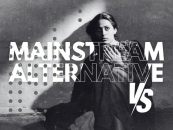
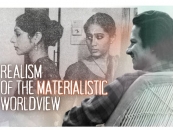
-173X130.jpg)
